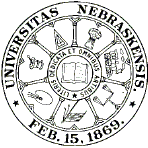
University Studies (University of Nebraska) (1888–1984)
Date of this Version
4-1918
Citation
1918 by The University of Nebraska Printed in the United States by the University 01 Nebraska Printing Division
Abstract
Formerly otters were very common along all of our Nebraska streams. In the winter of 1819-20 they were found frequently on the Missouri river and tributary streams near Engineer Cantonment (north of Omaha), as reported by Edwin James, that botanist and geologist of the Major S.H. Long Expedition. At Fort Kearny, Nebraska, on July 5, 1856, W.S. Wood with Lieut. F.T. Bryan's survey party obtained a young female otter which is now Cat. No. 1877 (skin) and 2575 (skull) of the U.S. National Museum. Otters were also extensively and persistently trapped by the early trappers and Indians, and due to this fact, they became less and less common year by year until their local extirpation along the streams in the more settled portions of the state took place. However, as late as 1880 Aughey stated that the otter occurred "more or less abundantly" on all of the Nebraska rivers.

